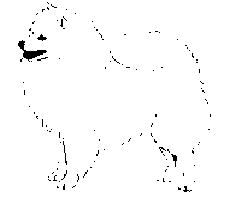Japanese Spitz
General Information - Japanese Spitz

Group:
Non
sporting
Size:
small
Lifespan:
12-15 years
Exercise:
medium
Grooming:
high
Trainability:
medium
Watchdog ability:
very high
Protection ability:
very low
Area of Origin:
Japan
Date of Origin:
1900's
Other Names:
none
Original Function:
Companion, watchdog
History
The Japanese Spitz is assumed to be a miniaturisation of the Samoyed, the breed that travelled with nomadic tribes from Mongolia, and so is thought by some to not be related to the American Eskimo Dog; however, there is some disagreement on that point. It is conjectured that it dates to the early 1900's and was developed as a companion first, and a watchdog later.
Temperament
The Japanese Spitz is a bold and intelligent little dog that has courage beyond its size, and makes a wonderful companion. A lively dog, it may have a tendency to bark a lot, especially to warn you when strangers approach.
Upkeep
The Japanese Spitz is active and needs exercise every day, either in the form of a walk or a vigorous play session. It can live outdoors in temperate to cold climates, but it much prefers to live indoors with its human family. Its thick coat needs brushing and combing two to three times a week, daily when shedding.
Japanese Spitz
A breed standard is the guideline which describes the ideal characteristics, temperament, and appearance of a breed and ensures that the breed is fit for function with soundness essential. Breeders and judges should at all times be careful to avoid obvious conditions and exaggerations, as well as being mindful of features which could be detrimental in any way to the health, welfare or soundness of this breed.
Breed Standard - Japanese Spitz
 Charactertistics
Charactertistics: Intelligent, bold and lively.
General Appearance: Profuse, pure white offstanding coat. The dog should have a sharply pointed muzzle and triangular shaped ears standing erect. Bushy tail carried over the back. The overall quality of the body should be firm and strong, full of flexibility. Fore and hind quarters should be well proportioned and balanced.
Head and Skull: Head of medium size without coarseness, moderately broad and slightly rounded. Skull broadest at occiput; well defined stop; cheeks rounded; forehead not protruding. Muzzle sharply pointed neither too thick nor too long. Lips firm and tightly closed, with black colour desirable. The nose round and small and black in pigmentation.
Eyes: Of moderate size, almond shape, set rather obliquely and not too wide apart; dark in colour with black eyerims.
Ears: Small, triangular and standing erect. Set high, forward facing and not too wide apart.
Mouth: The jaws should be strong, with a prefect regular and complete scissor bite, i.e., the upper teeth closely over lapping the lower teeth and set square to the jaw.
Neck: Strong and of moderate length.
Forequarters: Shoulders well laid. Forelegs straight with elbows firm and tight and pasterns slightly sloping.
Body: Chest broad and deep. Ribs powerfully sprung; belly moderately firm with good tuck-up. Withers should be highly developed and back should be straight and short. Loins should be broad and firm. Croup should be comparatively long and slightly arched.
Hindquarters: Muscular and moderately angulated. Hind legs parallel to each other viewed from the rear.
Feet: Toes should be small, round and cat-like. Well padded with good pigment. Nails should be hard and black or dark.
Gait: Light and nimble, active, energetic and very smooth.
Tail: Moderate in length with root set high and curled over the back.
Coat: The outer coat should be straight and stand-off. Profuse under coat, short, dense and soft in texture. Shorter on the face, ears, front parts of fore and hind legs and below hocks. All the other parts of the body covered with long coat. Mane on the neck and shoulder, reaching down to the brisket. Tail profusely covered with long hair.
Colour: Pure white.
Size: Height at shoulder 30 - 40 cm (12 - 16 in) for males, 25 - 35 cm (10 - 14 in) for females.
Faults: Any departure from the foregoing points should be considered a fault and the seriousness with which the fault is regarded should be in exact proportion to its degree.
Note: Male animals should have two apparently normal testicles fully descended into the scrotum.
DNZ No 738
Copyright Dogs New Zealand
01 Jan 2002
Any departure from the foregoing points should be considered a fault and the seriousness with which the fault should be regarded should be in exact proportion to its degree and its effect upon the health and welfare of the dog and on the dog’s ability to perform its traditional work.




